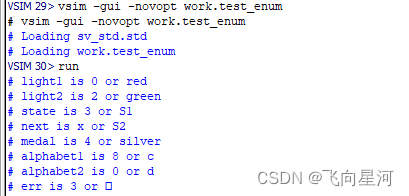SV学习——数据类型(1)
文章目录
- 1. 内建数据类型
- 2. 用户自定义
- 3. 枚举类型
1. 内建数据类型
SV中引入新的数据类型logic,SV作为侧重于验证的语言,并不十分关切logic对应的逻辑应该被综合位寄存器还是线网,因为logic被使用的场景如果是验证环境,那么它只会作为单纯的变量进行赋值操作。
引入的一个新的四态数据类型logic,可以代替reg;但是不能用在双总线和多驱动的情况下,此时只能使用网线类型,例如wire。
logic虽然只是表示数据类型,而在声明时,它默认会表示变量类型(variable),用户也可以显式声明其类型;
var logic [63: 0] addr; // a 64-bit wide variable
wire logic [63: 0] data; // a 64-bit wide net
与logic相对应的是bit类型,他们均可以构建矢量类型(vector),区别:
bit a ; // 两态,单比特
bit [31: 0] b32 ; // 两态,32比特无符号
int c32 ; // 两态,32比特有符号
byte d8 ; // 两态,8比特有符号
shortint e16 ; // 两态,16比特有符号
longint f64 ; // 两态,64比特有符号
2. 用户自定义
在SV使用typedef关键字进行用户自定义类型的扩展。定义新的数据类型可以提高代码的可读性,复杂的数据类型(结构体、联合体)和特定的数组可以通过使用一个简单易懂的名字(别名)被定义为一个新的数据类型,这个新的类型就可以定义对应的变量:
typedef int my_favorite_type;
my_favorite_type a, b;
这样的方法不是创建新的数据类型,只是在做文本替换;将一个特定的数组定义为新的数据类型:
parameter OPSIZE = 8;
typedef reg [OPSIZE-1: 0] opreg_t;
opreg_t op_a, op_b;
如果使用空的typedef事先对一个数据类型作出标识,那么它就可以在其定义之前使用:
typedef foo;
foo f = 1;
typedef int foo;
一个用户自定义类型需要在类型的内容被定义之前声明。这对于由enum、sturct、union、class派生出的用户自定义类型很有用处:
typedef enum type_declaration_identifier;
typedef struct type_declaration_identifier;
typedef union type_declaration_identifier;
typedef class type_declaration_identifier;
typedef type_declaration_identifier;
某些情况下,定义一个新的数据类型是必须的,因为在SV中要用过数据类型的标识符才可以做类型转换:
// typedef_example
module test_typedef ();
typedef enum {red, green, blue, yellow, white, black} colors;
colors my_colors;
initial begin
$display ("my_colors's defaut value is %s", my_colors);
my_colors = green;
// my_colors = 1; // err 需要做数据类型转换
my_colors = colors'(3); // 通过colors数据类型标识符做类型转换
$display ("my_colors is %s", my_colors.name);
end
endmodule
3. 枚举类型
规范的操作吗和指令例如ADD、WRITE、IDLE等有利于代码的编写和维护,它比直接使用 'h01 这样的常量使用起来可读性和可维护性更好;
枚举类型enum经常和typedef搭配使用,由此便于用户自定义枚举类型的共享使用;
枚举类型的出现保证了一些非期望值的出现,降低来了设计风险;
enum [data_type] {name1 = value, name2 = value2, ..., nameN = valueN} var_name;
enum {red, yellow, green} light1, light2;
无论是枚举名(red/yellow/…)还是他们的(整型)数值都必须是唯一的。他们的值可以被设置为任意整型常量值,或者从初始值0开始递增(默认情况)。
代码示例:
// enum_example
module test_enum ();
// 默认值:red = 0, yellow = 1, green = 2;
enum {red, yellow, green} light1, light2; // 未命名的枚举类型(int类型)
// 正确使用方法:IDLE = 0, S0 = 2, S1 = 3, S2 = x
enum integer {IDLE, S0 = 'b10, S1 = 'b11, S2 = 'x} state, next;
// 正确定义方法:silver和glod都没有指定大小
enum {bronze = 3, silver, gold} medal; // silver = 4, gold = 5
// c被自动地指定为8
enum {a = 3, b = 7, c} alphabet1;
// d = 0, e = 7, f = 8
enum {d, e = 7, f} alphabet2;
initial begin
light1 = red ;
light2 = green ;
// light1 = gold; // err
$display ("light1 is %0d or %s", light1, light1);
$display ("light2 is %0d or %s", light2, light2);
state = S1;
next = S2;
$display ("state is %0d or %s", state, state);
$display ("next is %0d or %s", next,next);
medal = silver ;
$display ("medal is %0d or %s", medal, medal);
alphabet1 = c ;
$display ("alphabet1 is %0d or %s", alphabet1, alphabet1);
alphabet2 = d ;
$display ("alphabet2 is %0d or %s", alphabet2, alphabet2);
end
// try something else
reg [ 3: 0] err;
initial begin
err = a;
$display ("err is %0d or %s", err, err);
end
endmodule
typedef enum {INIT, DECODE, IDLE} fsmstate_e;
fsmstate_e pstate, nstate; // 声明自定义类型变量
case (pstate)
IDLE: nstate = INIT; // 数据赋值
INIT: nstate = DECODE;
default: nstate = IDLE;
endcase
$display ("Next state is %s", nstate.name());
**枚举类型可以直接赋值给整型,整型不能直接赋值给枚举类型,需要做一个枚举类型的类型转换,这样在仿真的时候更安全。
INT = enum;
enum = ENUM'(INT);
// enum_test
module enum_test ;
// 默认值:red = 0, green = 1, blue = 2;
typedef enum {red, green, blue} Colors;
Colors my_color;
initial begin
my_color = red;
$display ("@0 my_color is %d or %s", my_color, my_color);
my_color = blue;
$display ("@1 my_color is %d or %s", my_color, my_color);
// my_color = int'(2); // err
// // An enum variable 'my_color' of type 'Colors' may only be assigned
// // the same enum typed variable or one of its values.
// // Value '2' requires an explicit cast.
// $display ("@2 my_color is %d or %s", my_color, my_color);
my_color = Colors'(1);
$display ("@2 my_color is %d or %s", my_color, my_color);
end
endmodule
版权声明:本文为CSDN博主「Bunny9__」的原创文章,遵循CC 4.0 BY-SA版权协议,转载请附上原文出处链接及本声明。
原文链接:https://blog.csdn.net/Bunny9__/article/details/122494130


